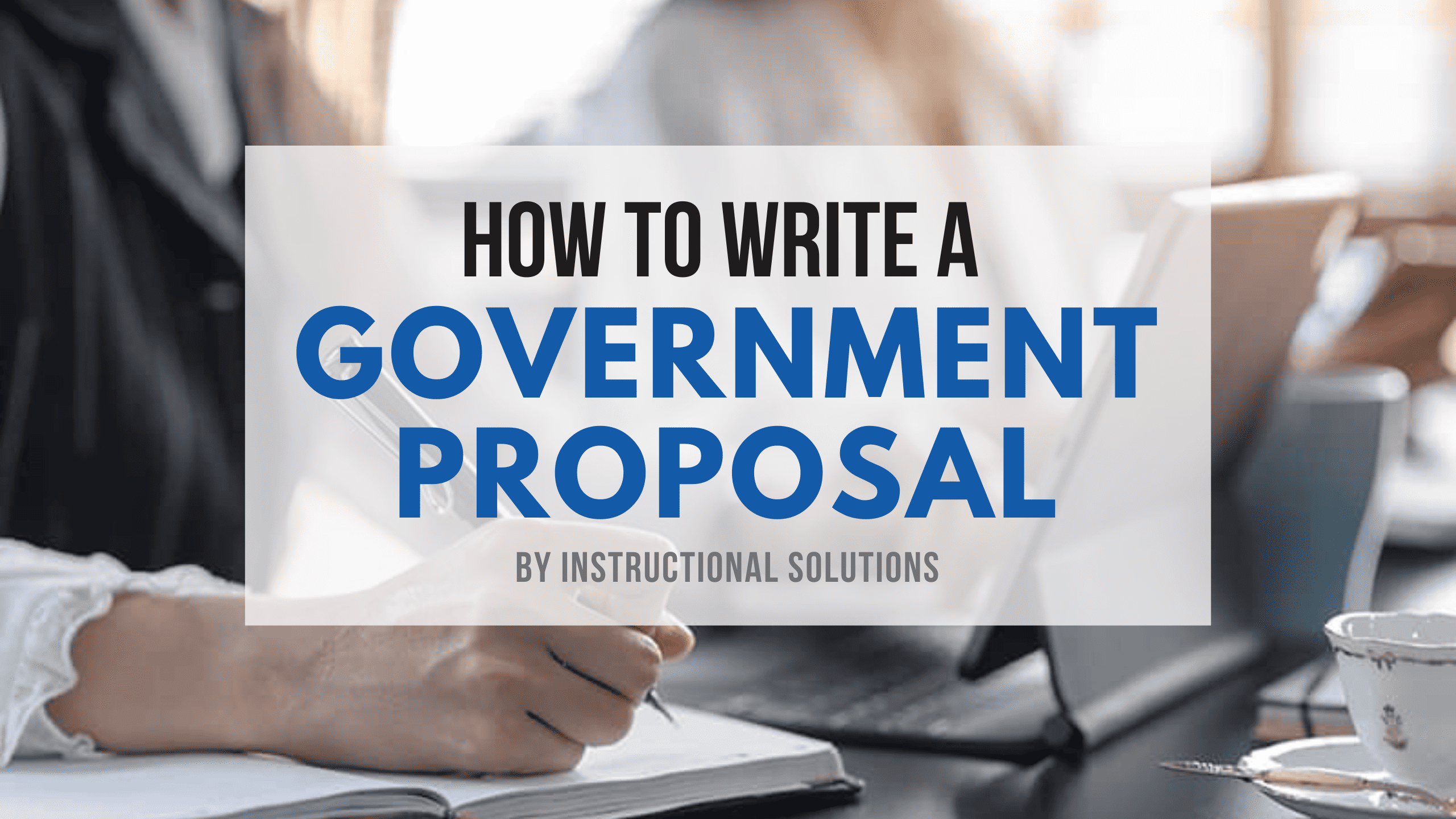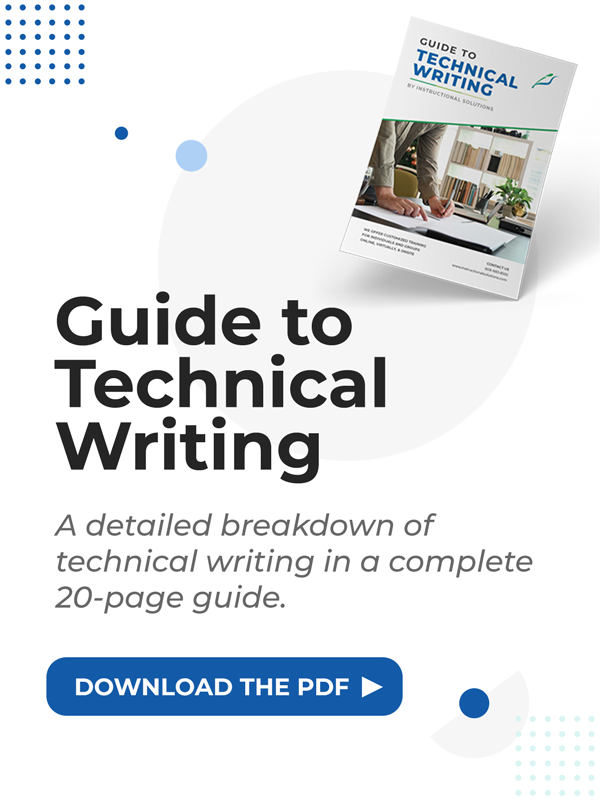How to Write a Government Proposal

Originally published February 19, 2024, updated February 20, 2024

Table of Contents
What Is a Government Proposal?
A government proposal is a written document submitted by a private company to win a contract from the federal government. The FAR (Federal Acquisition Regulations) handles all government proposals, and various laws and protocols must be met when crafting one. A typical government proposal might include a schedule of work, cost breakdowns, references, performance guarantees, plus other elements depending on the nature of the project.
Government proposal writing is often lengthy and requires time and research to succeed. A writer must understand the proposal guidelines to create the most compelling document possible. Guidelines include outlining proper details such as accurate pricing, proposed timelines for completion of service or delivery dates, and stating any value-added services that may fulfill the customer’s need beyond the simple goods or services offered. By taking steps such as these, companies can submit more attractive bids that will help maximize the chances of winning the solicitation.
What’s the Difference Between Grant Writing and Proposal Writing?
Grant writers focus on finding potential sources for funding opportunities, while proposal writers focus on crafting persuasive documents to increase their chances of success. Both activities are crucial in helping organizations secure the necessary funds to achieve their goals.
Understanding the Government Writing Terminology
Government agencies release different types of orders that are accessible to the public.
- The request for information (RFI) aims to explore potential solutions the vendors offer.
- A request for proposal (RFP) assesses the overall value that a vendor can provide.
- The request for quotation (RFQ) provides a detailed cost breakdown to meet a specific need.
Become a strong proposal writer in our online self-paced business writing course
View the OutlineA Contracting Officer (CO) is the person who negotiates on behalf of the government. Only Contracting Officers (CO) can execute, modify, or terminate a contract as the Government's agent. The agency decides if there is a need for Contracting Officers domestically or overseas.
Government Proposal Writing Overview
Proposal writing for government contracts can be difficult even for the most experienced proposal writers and business owners.
Crafting an accurate and competitive proposal requires the following:
- Thorough research
- A clear understanding of the specific requirements of the agency offering the contract
- An in-depth assessment of your capabilities as a provider
- Well-written content that accurately presents your qualifications to meet those needs.
Beyond ensuring the proposal complies with any regulations or policies set by the funding body or government agency, it’s essential to show how the company is uniquely qualified to succeed. Every detail must be precise and submitted before the imposed deadline. Let's explore the government proposal review process.
1. Preparation and Requirements
Before submitting a proposal, businesses must consider and carefully establish what resources are needed for the project. The preparation process is often the most time-consuming. To ensure that the proposals accurately capture the customer’s desired solutions, writers should consult with end users or internal stakeholders involved in the project so that their requirements can be properly articulated.
When gathering all of the pertinent information to include in a requisition for quotation (RFQ), there are some basic questions that business owners should answer:
- What will be my budget?
- How long do I expect this project to take?
- Who are all of the parties involved in this project?
- Is there any specific feature or capacity that I require from my supplier?
By addressing and answering these questions as thoroughly as possible, the proposal will have the best chance of receiving suitable responses tailored to their needs.
2. Issuing and Management
The Contracting Officer (CO) is responsible for issuing the Request for Quote (RFQ). This is critical to ensure the supplier can craft an acceptable and timely quote. The business will limit the number of respondents to encourage healthy competition and force those invited to submit a response to do so quickly. It's important to note that enough time should be given to the supplier team, so at least give them a few weeks to elaborate on their plan.
The next stage of the process is handling questions from any participants involved in this transaction. Generally speaking, these queries are public-facing, allowing everyone to read responses from the proposal recipient and stay up-to-date with current changes. This effectively keeps everyone aware of updates and ultimately leads to streamlined procurement processes for all parties involved.
3. Scoring and Selection
The Request for Quotation (RFQ) process is a tried and true tool for businesses to obtain competitive quotes for goods or services. The significant benefit of RFQ for the proposal recipient is that it facilitates an efficient scoring and selection process.
- First, the business will prepare the RFQ document, which includes criteria for each bidder's need. Most RFQs have price as a criterion, but other criteria such as track record, delivery capability, and resources may also be important in evaluating vendors to identify who offers the best value, not just in terms of pricing but overall quality standards.
- Once the bids are received, the proposal recipient can quickly evaluate each bid against established criteria and compile a list of contractors ranked according to their score.
- The proposal recipient should then select several vendors based on this evaluation to move on to further review. This review might consist of structured reference checks, interviews, or additional negotiation.
Get one-on-one coaching and feedback on your actual writing.
Learn More4. Closing and Contracting
Closing and contracting are essential in the request for proposal (RFP) selection process. After selecting a vendor, the government grant manager will issue them an award email containing a quote. This quote represents the vendor's best offer to fulfill the project's requirements but is not yet a formal agreement. There may be further negotiations with the vendor to ensure that both parties are satisfied with all the details before presenting them with a contract.
- Once an agreement has been reached and everything finalized, the proposal recipient will create a contract document that includes specific terms related to billing information, deliverables, and other details outlined in the initial RFP documents.
- When both parties sign off on the contract, the selected vendor can deliver their services or goods as stipulated in the document.
- Additionally, other vendors who participated in bidding for this project will receive communication via rejection letter informing them that their bid did not meet expectations or was unsuccessful for whatever reason.
5. Review and Evaluation
An effective supply management process is crucial for the success of your business. After signing a contract with a specific vendor, it is important to have a supplier evaluation meeting to measure the vendor's performance and check if they are successfully meeting their contractual obligations. The proposal recipient will conduct a thorough assessment, paying close attention to the promised value and how it has been delivered. This assessment includes quality control, delivery times, cost controls, communication levels, and order accuracy.
In addition to this initial evaluation meeting, ongoing engagement with suppliers to maintain an up-to-date view of their services and performance. Regular supplier performance reviews are essential for sustaining and developing positive relationships between both parties over time. Effective collaboration throughout purchasing can lead to significant cost savings for all involved. With proper review and evaluation procedures in place, organizations can ensure that they’re always getting maximum value from their suppliers.
Strategies for Writing a Strong Government Proposal
1. Be Consistent
Consistency in your work is essential to creating and maintaining a professional image. A set framework for your proposals helps you streamline the process, saving time and stress. Creating a template for different situations ensures that your communication remains uniform across all your projects. Clients will appreciate this sense of organization.
Consistency with formatting, language, structure, document layout, and design choices creates familiarity with your brand identity and gives legitimacy to each proposal. Consistency is a key aspect of professionalism that encourages clients to form lasting relationships.
2. Understand the Requirements
Writing a government proposal for a company will involve many people. Each department or agency has distinct needs, and complying with all requirements is essential to secure the project. Crafting the proposal in a way that conveys both insight and expertise will show potential partners that you have taken the time to understand their specific goals. Establishing a well-structured message is paramount when creating bid documents.
Adhere to language conventions such as dictionaries and watchword lists to ensure detailed, comprehensive responses that address each reviewer's requirement head-on. Utilize plain language to ensure accuracy and clarity in your writing. You'll enable interested parties to understand better how your products or services provide the best outcome for the project needs. Maintaining a consistent tone throughout your document will demonstrate your capability to deliver on expectations, showcasing why the business is preferred among competitors.
3. Make a Good First Impression
Making an excellent first impression is essential. This is especially true when responding to a request for proposal (RFP) process, where you will compete against other potential vendors. This opening includes sections such as a cover letter and an executive summary, key elements establishing credibility and setting the company apart from the competition.
It is often wise to craft these components as the final paragraphs of your proposal - by putting them last in the writing process, you can ensure that they are concisely worded and correctly highlight what makes your organization and solution unique. Utilize these sections to address head-on why you are best placed to help the department meet its goals. Additionally, focus on what makes you different from competitors — elaborate on any differentiating features or processes that could give you the edge over others. By ensuring that this information stands out clearly in your presentation, you can capture the attention and elicit interest from the RFP reviewers.
4. Use Irrefutable Proof Points and Case Studies
Proof points and case studies are invaluable for convincing a government agency that the company can deliver the project successfully. Providing irrefutable proof of previously completed successful projects gives the hiring team confidence that you have done similar work and can meet their needs.
You should present examples from past projects alongside clear evidence demonstrating best practices, operational excellence, on-time delivery, cost savings, and other relevant criteria. Introduce the team handling the contract, including details on their experience and qualifications; this will further assure the hiring team. Complement this with additional information, such as customer testimonials or references. Awards won for previous contracts and positive feedback from supervisors or partners strengthen the proposal further. Prove that the company understands the requirements and can deliver outstanding results quickly and efficiently; this sets your proposal apart from competing firms.
5. Include Visual Aids
Visual aids such as diagrams, charts, and images can effectively communicate complex information to an audience. Visuals help provide context and aid in understanding a topic that may otherwise be difficult for people to comprehend. For example, if you are trying to explain how the company will incorporate a specific tool, you could use visuals like photos or illustrations to guide readers. Additionally, maps and graphs can be used effectively to visually demonstrate data trends or geographical differences between subject matters over time.
6. Outline Your Strategy To Meet Deliverables
To meet the government RFP deliverables, develop a strategy. Assess the project's complexity and determine a timeline. Identify challenges and opportunities for improvement. Coordinate with team members to allocate resources and divide duties. Maintain regular communication to track progress. Consider third-party assistance within budget constraints if necessary. Meeting deliverables is crucial for project success; this strategy organizes thoughts to achieve them.
7. Personalize Any Boilerplate Content
When submitting multiple proposals yearly, keeping a boilerplate (templated) document ready can save you time. It adds efficiency and organization to your proposal process. However, it's also important to personalize some details in each proposal where appropriate so that it is relevant. For example, always include the most recent data. Also, double-check your document for copied and pasted information from a previous proposal that might need clarification in the current one.
Learn how to write a government proposal and get detailed feedback on it.
Learn More8. Write With a Single Voice
Writing a compelling RFP response can be challenging when multiple people are contributing. Use a single voice throughout the document to maintain a consistent narrative. Use the same tone, language style, and technical terms for each section. Tenses should also stay consistent; all sentences should use past or present tense, but not both. In addition, avoid jargon and abbreviations as much as possible to ensure everyone who reads the RFP has an equal opportunity to understand it and submit an answer.
A unified voice demonstrates to potential clients that you can collaborate effectively and efficiently with your team members. Consistency from start to finish conveys professionalism, which could make all the difference between landing or losing a bid for a significant government contract.
9. Create a Proposal Writing Style Guide
Creating a unified corporate vision involves crafting a detailed proposal writing style guide. By following this guide, you ensure accuracy in terminology and fact-based work in any language used in the final product. It helps to ensure that every detail aligns with the organization's mission and values. The style guide should include specific grammar elements, structural conventions, subject title styles, section headings, referencing approaches, indexing, tables of contents, illustrations, graphic elements, spellings of words, third-party sources, formatting guidelines, and other necessary items for successful proposal development.
10. Proofread Multiple Times
Using automated and human proofreaders is vital to preparing your RFP response. Automated tools, like proposal writing software, can help with formatting and catching common errors. AI scans for issues like wordy sentences or grammar mistakes. These programs can also identify the overuse of the passive voice.
A human reviewer can assess the writing's quality and flow. This attention to detail is crucial in competitive bid situations. Before submitting an RFP response, use both automated and human proofreaders to increase your chances of success.
Writing government contract proposals is a time-consuming process. However, it is vital for many businesses. Adding proposal writing to your technical writing resume is an excellent way to expand your clientele. Learn more about this valuable skill through our Proposal Writing Course.




